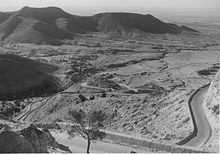Operation Skorpion
| ||||||||||||||||||||||||||||
| ||||||||||||||||||||||||||||
Operation Skorpion 26–27 May 1941, was a military operation during the North African Campaign of World War II, fought between Axis forces under General Erwin Rommel and British forces under General "Strafer" Gott; it was Rommel's second offensive operation in Africa. A counter-attack was made on British positions at Halfaya Pass in north-western Egypt, captured during Operation Brevity (15–16 May). Skorpion pushed the British out of Halfaya Pass and back to the Buq Buq–Sofafi line.
Background
After the great British victory over Italian forces in Operation Compass, the German high command ordered Operation Sonnenblume which sent Rommel and the Deutsches Afrika Korps (DAK) to reinforce the remnants of the Italian 10th Army. Rommel attacked at once and drove the British forces from central Libya back across the Egyptian border, except for the fortress of Tobruk, which began a nine-month siege. Axis forces advanced about 15 kilometres (9.3 mi) into Egypt and occupied the port of Sollum and the Halfaya Pass to the south-east. The pass is a gap in the escarpment which separates the narrow coastal plain from the Sahara Desert and is about 1-kilometre (0.62 mi) from the coast. British forces attacked in Operation Brevity (15–16 May), through Halfaya Pass to attack the desert flank of the Axis forces and reach Fort Capuzzo in Libya. The British were repulsed but held on to Halfaya Pass.[1]
Battle

During the evening of 26 May, Kampfgruppe von Herff (Oberst Maximilian von Herff), comprising three panzer battalions, assembled on the coast at the foot of Halfaya Pass and attacked the next morning, intending to bluff the British into retiring.[2][3] The pass was defended by the 3rd Coldstream Guards and supporting units but the bluff became a genuine attack and secured a commanding position, leaving the British in danger of being surrounded and cut off. During the morning, Gott authorized a withdrawal and the Coldstreams commander, Lieutenant-Colonel Moubray extricated the battalion with great skill.[4] There were no other British forces near and Gott ordered a withdraw from the pass, which was re-occupied by the Axis.[5]
Aftermath
Analysis
After the re-capture of Halfaya Pass, the mainly German troops in the area, fortified the frontier positions, the Gazala Line and Tobruk. Halfaya, Qalala, Point 206 and Point 208 were prepared for all-round defence and camouflaged. The British prepared for Operation Battleaxe, which was due to begin as soon as the tank reinforcements of the Tiger convoy were ready.[6]
Casualties
British casualties were 173 men, 4 field guns, eight anti-tank guns and five I tanks. German casualties have not been established[7]
See also
- North African Campaign timeline
- List of World War II Battles
Footnotes
References
- Howard, Michael; Sparrow, John (1951). The Coldstream Guards, 1920–1946. Oxford University Press. OCLC 9151069.
- Jentz, Thomas L. (1998). Tank Combat In North Africa: The Opening Rounds, Operations Sonnenblume, Brevity, Skorpion and Battleaxe, February 1941 – June 1941. Atglen, PA: Schiffer. ISBN 0-7643-0226-4.
- Playfair, Major-General I. S. O.; with Flynn R. N., Captain F. C.; Molony, Brigadier C. J. C. & Toomer, Air Vice-Marshal S. E. (1956). Butler, J. R. M., ed. The Mediterranean and Middle East: The Germans come to the help of their Ally (1941). History of the Second World War, United Kingdom Military Series II (Naval & Military Press 2004 ed.). London: HMSO. ISBN 1-84574-066-1.
- Rommel, Erwin (1982) [1953]. Liddell-Hart, Basil, ed. The Rommel Papers. Da Capo Press. ISBN 0-306-80157-4.
Further reading
- Bradford, G. R. "Brevity and its Impact on the DAK". Archived from the original on 2009-10-26. Retrieved 27 February 2015.
- Paterson, I. A. "History of the British 7th Armoured Division: Operation Brevity". Retrieved 27 February 2015.
External links
| Wikimedia Commons has media related to Operation Skorpion. |
